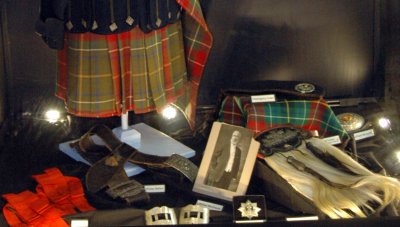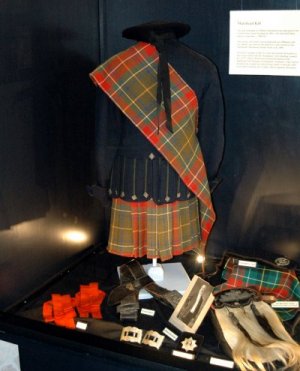The Muirhead Kilt
The Muirhead Kilt
The Scottish Tartans Museum is the home of a very unique piece of Scotland’s clothing history. Thanks to a generous donation from his descendants, a kilt outfit worn by William Muirhead, born in Edinburgh, Scotland in 1835, is now on display in the Scottish Tartans Museum.
Muirhead migrated to the United States in 1854, at the age of 19. According to family tradition, he brought his kilt with him, a reminder of his homeland. To his family, this outfit is a treasured heirloom. To Scottish clothing historians, it is a rare and treasured find.
Kilts have been worn in the Highlands of Scotland for about 400 years. The earliest form of kilt was called the feileadh-mhor (Gaelic for “large wrap”), and was a large tartan blanket that covered the wearer from the shoulders to the knees, gathered into folds and belted at the waist. A later form was the feileadh-beg (“small wrap”), which was the same garment, but only covering from the waist to the knees. In the 1790s tailors began to sew the pleats into the feileadh-beg and this became the modern tailored kilt.
The Scottish Tartans Museum has two kilts on display that date from this early era (c. 1800). They differ from modern kilts in that they are box pleated (not knife pleated) and contain only about four yards of tartan cloth. Today’s standard kilt has eight. Throughout the nineteenth century, styles changed as the garment slowly evolved into the familiar kilt of today.
One of the more unique styles was called “Kingussie pleating.” In this case, the center pleat on the kilt is a box pleat, with knife pleats to either side going in opposite direction. This style of pleating got its name from the town of Kingussie, Scotland, where until now the only kilt known to be pleated this way was on display.
The Muirhead kilt is only the second kilt found to be pleated in this fashion, making it very important to Highland dress historians. The tartan the kilt is made from is also very unique. No tartan like it has ever been recorded. In recent years, descendants of Scottish Muirheads (variant spellings of the name include Morehead and Moorhead) have formed a Clan Muirhead Society. When Society president Raymond Morehead heard of this kilt, he proposed that the unique design be adopted as the Muirhead family tartan. In the year 2000, the Clan Muirhead Society officially adopted a slightly altered version of this tartan as their own.
Visitors to the Scottish Tartans Museum can see the entire outfit, including the kilt, a doublet, sporran, sash, brooch, cap, and other accessories, during their visit at the museum.
Museum director Matthew Newsome states, “Being a museum of Highland clothing located on the other side of the Atlantic from Scotland, of course we have to rely quite a bit on reproduction pieces to show the story of the development of the kilt. But we are very lucky to have so many authentic kilts dating from the past 200 years.
“We already had two kilts on display from about the year 1800. Only a dozen or so kilts of that age are known to survive, and that’s world wide. More recently we were blessed with gifts of two more full outfits from the late nineteenth century. And now to have this Muirhead kilt, we are able to show our visitors the complete story of the tailored kilt’s evolution, from its origins to the present day, with authentic examples.”



